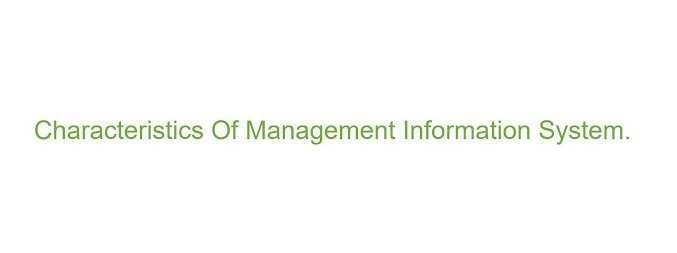Characteristics Of Management Information System.
- System Approach:
The information system follows a System’s approach. The system’s approach implies a holistic approach to the study of system and its performance in the light for the objective for which it has been constituted.
- Management Oriented:
The top-down approach must be followed while designing the MIS. The top-down approach suggests that the system development starts from the determination of management needs and overall business objectives.
The MIS development plan should be derived from the overall business plan. Management oriented characteristic of MIS also implies that the management actively directs the system development efforts.
- Need-Based:
MIS design and development should be as per the information needs of managers at different levels, strategic planning level, management control level and operational control level. In other words, MIS should cater to the specific needs of managers in an organization’s hierarchy.
- Exception Based:
MIS should be developed on the exception-based reporting principle, which means an abnormal situation, i.e. the maximum; minimum or expected values vary beyond tolerance limits. In such situations, there should BE exception reporting to the decision-maker at the required level.
- Future Oriented:
Besides exception-based reporting, MIS should also look at the future. In other words, MIS should not merely provide past or historical information; rather it should provide information, on the basis of projections based on which actions may be initiated.
- Integrated
Integration is a necessary characteristic of a management information system. Integration is significant because of its ability to produce more meaningful information. For example, in order to develop an effective production scheduling system, it is necessary to balance such factors as setup costs, Workforce, Overtime rates, Production capacity, Inventory level, Capital requirements and Customer services.
- Long Term Planning:
MIS is developed over relatively long periods. Such a system does not develop overnight. A heavy element of planning is involved. The MIS designer must have the future objectives and needs of the company in mind.
- Sub-System Concept:
The process of MIS development is quite complex and one is likely to lose insight frequently. Thus, the system, though viewed as a single entity, must be broken down into digestible sub-systems which are more meaningful at the planning stage.
- Central Database:
A central database is a mortar that holds the functional systems together. Each system requires access to the master file of data covering inventory, personnel, vendors, customers, etc. It seems logical to gather data once, validate it properly and place it on a central storage medium, which can be accessed by any other subsystem.

